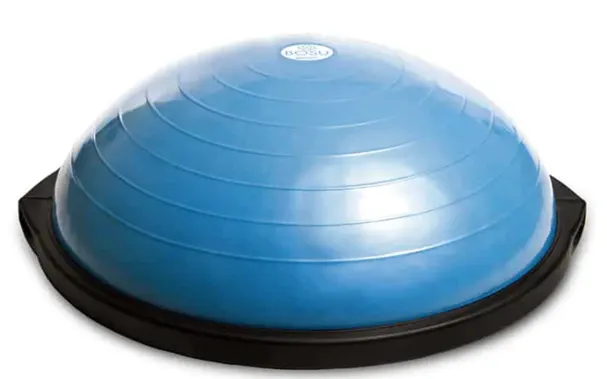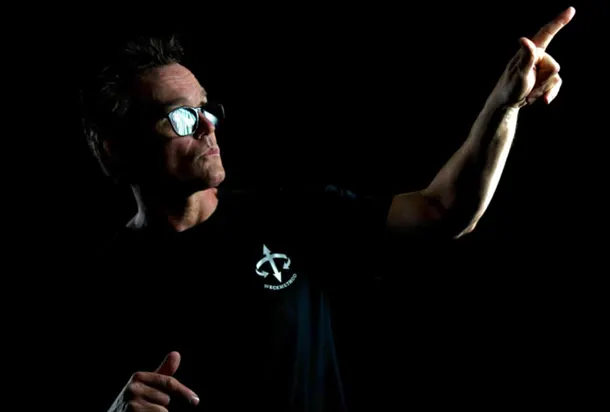Introduction
David Weck has had a sizeable impact on the fitness industry in his career as a coach, teacher, and inventor.
And while Weck is most known for inventing the BOSU Balance Trainer and founding WeckMethod, his inventiveness extends much further.
This article will provide biographical research on David Weck and act as a living archive of his contributions to athletics and biomechanics.
Americas Unknown Hero
David Weck’s output over the past 30 makes him one of the most prolific inventors that the USA has ever produced.
His work has helped millions of people across the globe. From world-class athletes breaking new records to disabled individuals regaining the ability to walk.
Weck’s equipment inventions and biomechanics concepts have stood the test of time.
And even though Weck has been making world-class inventions for the last 30 years…
Most people still haven’t heard his name.


Early Life and Education
David Weck was born for greatness.
Who would have guessed his aspirations to succeed as an actor would be dashed by even bigger success as an inventor?
Not much information is public about David Weck’s early life or childhood upbringing.
In one interview about the invention of the BOSU ball, he recalls being “28 years old in 1998.”
Quick math places his birthday in 1970 meaning he is approximately 54 years old at the time of this writing.
Weck holds a B.A. in Political Economics from Williams College in Massachusetts.
He also attended Pacific College of Health and Science school of Traditional Chinese Medicine (TCM) and holds a degree in Acupuncture and Oriental Medicine.
He played three years of Division III football for Williams College as the starting Defensive Back under Hall of Fame coach Dick Farley, and competed in the decathlon and sprint events in track and field.
This explains why Weck loves to exemplify Deion Sanders running technique – not only a great runner, but the greatest Defensive Back of all time.
In 1989 Weck and the Williams Football team had a historic undefeated season and became the first college football program in history to play a perfect season. Weck was a key player in the victory sharing it with his team including Ted Rogers, Ken Dilanian, Brian Stevens, and Rich “Remo” Williams.
In the lead up to the big win, Weck learned valuable lessons from Coach Farley’s work ethic. When recalling his coaches dedication to the Football program, Weck described Farley as his ,“ #1 inspiration and motivation.” during his time at the college.

The mindset he carried toward his eventual success as an inventor came from concepts in Farley’s coaching.
One coaching idea that Weck borrowed from Farley was the “Eleven is One” concept and he breaks this down into a few main points.
- In sports and the military, everyone has an assignment
- Synchronization of purpose, drive, and timing are the fundamentals of acting as a team
- The body as a whole mimics these concepts
- No Man or Woman is an Island
- Integration and unified sequencing result in a wholistic attitude that serves the larger purpose
The purpose of this mental exercise is to observe each part of a system contributing to the whole.
Eleven becomes one in a unified sequence of motions. A valuable concept on training with a wholistic approach.
And observing Weck, it’s clear these ideas are woven into everything he does.
Like his concept of Both Sides Utilized taught within the BOSU Ball programming.
Or rope training’s use of programmed patterns to enhance communication between the left and right sides of the body.
But Weck didn’t begin as a star athlete – and he knew his physical inadequacies were going to be a limiting factor.
He had to use his inventive mind to unlock abilities beyond what was possible with traditional training.
New Avenues in Functional Training
That’s when he began to train his coordination using other athletes’ movements as a framework.
For 20 hours a week after football practice, Weck would watch game films of the great Deon Sanders and Dick “Night Train” Lane.
He would watch, and watch, and watch.
Then he would practice the movements he saw.
He got two results:
- Physically he could emulate the patterns of more skilled athletes, improving his athleticism directly
- Mentally he developed awareness of visual cues given by opponents movements for better in-game anticipation
At the time he was one of the first people using slow-motion films like this.
A practice that’s now become the standard in top athletic programs.
He would use the film footage as a guide to identify and improve natural movement sequences. In turn he would use his awareness of the sequences to gain an advantage on the field.
Weck could anticipate his opponents next step and employ their best movement strategies against them.
Staggering intelligence from young David Weck.
The edge gained from watching slow- motion film was Weck’s first eureka moment.
It formed the foundations of the WeckMethod curriculum now taught around the globe.
It’s an inspiring success in athletic and biomechanics innovation.
His skill for engineering complex ideas and creating new associations has been all his own.
And David’s innovations have been helping the world loyally for decades.
Making the world a better place to move.
Or as he puts it, “Making Every Step Stronger for Everyone”.

Early Career and Accomplishments
In Weck’s early career, he lived and worked in New York City as a fitness instructor trying to make it as an actor.
He was smart and charismatic but above all, he had drive and determination toward his goals.
In the story below he talks about inventing and constructing the first BOSU ball and how it set his life on a new path.
What’s inspiring is that he had the sensitivity to see the potential in his invention and to take action.
Even when it meant giving up his goal of having an acting career.
And when the BOSU proved it could be a success he had the courage to make it a reality for the world.
In the excerpt from The Todd Durkin Impact Show Ep. 205, Weck explains the origin of his first invention and shows his open-minded approach to full-hearted living.
David Weck (DW): I was living in NYC pursuing a career in acting and working as a fitness trainer. [laughs] At the time coaching was the, ya know, survival job – for rent and food.
I rollerbladed everywhere – and I’m a very intense person so that means if I do something I do it 100%.
So as a result I went 6 years without walking or running because I wore rollerblades all the time.
If I was outside I was rollerblading, and Manhattan is basically a skating rink, so I was holding onto cabs, jumping over stuff, and got really good at it.
But the consequence was that my feet trapped in these boots got super weak.
Well one day I got an acting job that paid me a decent amount of money and I got a motorcycle.
But it was a cheap motorcycle and the starter didn’t work… so I had to jump-start it.
I lived on 56th street [one way] and downhill was the wrong way.
So I’m side saddle on this motorcycle trying to pop the clutch and this car sort of swerves and I drop the bike.
And I lift it up as fast as I can and my back got twinged… and I was in agony.
3 days later I was with a client chatting and I was rollerblading when I collapsed.
Todd Durkin (TD): How old were you then?
DW: Then I was 28 and it was 1998, and I didn’t know then what I know now about the body and biomechanics.
It was my weak feet that couldn’t resolve the forces, strength, and tension through my body. And that ultimately led to a back problem that I couldn’t fix.
And finally, on my last day of physical therapy – the money was run out, my insurance was done, and it wasn’t better.
The therapist says here let me introduce you to this swiss ball.
So I started training with the swiss ball, and I started getting some results with it.
I discovered there was a reflexive, [self] righting, and internal adjusting that helps reset the nervous system.
Then one day I saw a picture of Paul Chek standing on the ball squatting and I thought “Well, hey let me try that.”
And so I stood on the ball, very cautiously at first, and I got rather good at it. And my feet regained their strength because I would stand on the swiss ball barefoot.
But the problem was that the risk-to-reward ratio very quickly changes, so the risk outweighs the reward.
I was literally jumping onto the ball, jumping from one to another, and I would take these big wipeouts.
TD: Wait, jumping from one ball to another?
DW: Yes
TD: Sounds like a recipe for disaster!
DW: Yes, with one thing being that when you’re [jumping] you’re prepared for the fall. But it turned out that the Feldenkreis-inspired minimalist stuff was where the real danger was.
The opposite end of the spectrum was more dangerous.
So, I would stand on it totally still, close my eyes, and tilt my head to cause vestibular perturbation.
Authors note: Vestibular perturbation refers to disrupting the normal functioning of the inner-ear vestibular system. The vestibular system handles maintaining balance, orientation, and coordinating eye movements. When Weck tilts his head like this, he’s creating great stimulus on the vestibular system due to the added instability of the swiss ball. To stay balanced in this way requires immense coordination.
One night, it was the New York Knicks losing in the finals and I was standing on a 75 mm swiss ball.
And I closed my eyes, tilt my head, and I fell off that thing – and I got scared.
I landed on it, did a backflip, and bounced on the other side of the apartment.
I started Kicking my legs to see if I could still do it!
I was terrified because I literally almost broke my neck.
So that night laying in bed pondering what to do, I was like… what if I cut the ball in half?
And then BOOM, AHA, EUREKA!!
I’ve never seen that before!
I immediately thought of all the things that I could do with it, and that [this design] would be SAFE!
So I drew pictures of it on an envelope that night.
The next day I canceled all my plans and went to the hardware store.
I took my stability ball and cut it in half with scissors.
I bought a round tabletop that was the right diameter, a whole bunch of staples, glue, and tape.
And I built the first prototype that Saturday after falling on a Friday.
The glue dried and Sunday it worked.
Durkin, Todd, host. Todd Durkin: Impact Show Ep. 205, 2021, https://todddurkin.com/meet-david-weck-the-mind-soul-of-the-bosu-inventor/.
The BOSU Ball Balance Trainer would be the first of several production inventions that Weck went on to make.
Click below to dive deeper into a review of David Weck’s tools and inventions.
